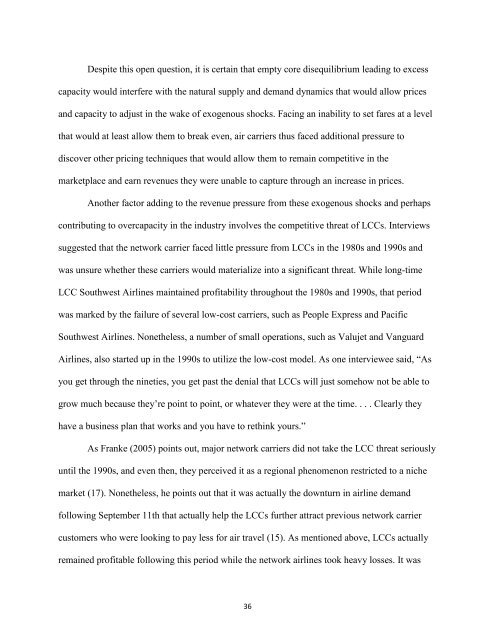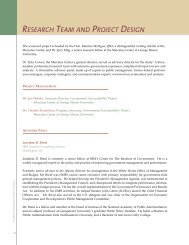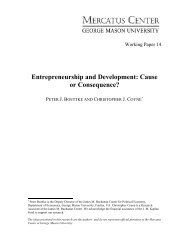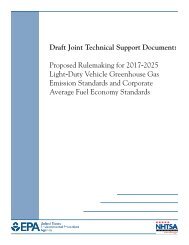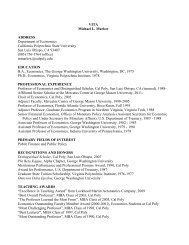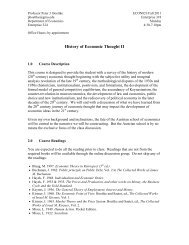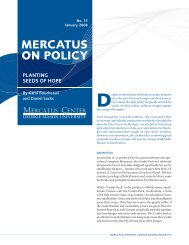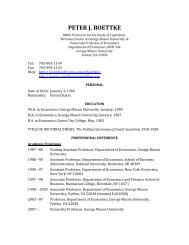A-La-Carte Pricing in the Airline Industry - Graduate Student ...
A-La-Carte Pricing in the Airline Industry - Graduate Student ...
A-La-Carte Pricing in the Airline Industry - Graduate Student ...
You also want an ePaper? Increase the reach of your titles
YUMPU automatically turns print PDFs into web optimized ePapers that Google loves.
Despite this open question, it is certa<strong>in</strong> that empty core disequilibrium lead<strong>in</strong>g to excesscapacity would <strong>in</strong>terfere with <strong>the</strong> natural supply and demand dynamics that would allow pricesand capacity to adjust <strong>in</strong> <strong>the</strong> wake of exogenous shocks. Fac<strong>in</strong>g an <strong>in</strong>ability to set fares at a levelthat would at least allow <strong>the</strong>m to break even, air carriers thus faced additional pressure todiscover o<strong>the</strong>r pric<strong>in</strong>g techniques that would allow <strong>the</strong>m to rema<strong>in</strong> competitive <strong>in</strong> <strong>the</strong>marketplace and earn revenues <strong>the</strong>y were unable to capture through an <strong>in</strong>crease <strong>in</strong> prices.Ano<strong>the</strong>r factor add<strong>in</strong>g to <strong>the</strong> revenue pressure from <strong>the</strong>se exogenous shocks and perhapscontribut<strong>in</strong>g to overcapacity <strong>in</strong> <strong>the</strong> <strong>in</strong>dustry <strong>in</strong>volves <strong>the</strong> competitive threat of LCCs. Interviewssuggested that <strong>the</strong> network carrier faced little pressure from LCCs <strong>in</strong> <strong>the</strong> 1980s and 1990s andwas unsure whe<strong>the</strong>r <strong>the</strong>se carriers would materialize <strong>in</strong>to a significant threat. While long-timeLCC Southwest Airl<strong>in</strong>es ma<strong>in</strong>ta<strong>in</strong>ed profitability throughout <strong>the</strong> 1980s and 1990s, that periodwas marked by <strong>the</strong> failure of several low-cost carriers, such as People Express and PacificSouthwest Airl<strong>in</strong>es. None<strong>the</strong>less, a number of small operations, such as Valujet and VanguardAirl<strong>in</strong>es, also started up <strong>in</strong> <strong>the</strong> 1990s to utilize <strong>the</strong> low-cost model. As one <strong>in</strong>terviewee said, ―Asyou get through <strong>the</strong> n<strong>in</strong>eties, you get past <strong>the</strong> denial that LCCs will just somehow not be able togrow much because <strong>the</strong>y‘re po<strong>in</strong>t to po<strong>in</strong>t, or whatever <strong>the</strong>y were at <strong>the</strong> time. . . . Clearly <strong>the</strong>yhave a bus<strong>in</strong>ess plan that works and you have to reth<strong>in</strong>k yours.‖As Franke (2005) po<strong>in</strong>ts out, major network carriers did not take <strong>the</strong> LCC threat seriouslyuntil <strong>the</strong> 1990s, and even <strong>the</strong>n, <strong>the</strong>y perceived it as a regional phenomenon restricted to a nichemarket (17). None<strong>the</strong>less, he po<strong>in</strong>ts out that it was actually <strong>the</strong> downturn <strong>in</strong> airl<strong>in</strong>e demandfollow<strong>in</strong>g September 11th that actually help <strong>the</strong> LCCs fur<strong>the</strong>r attract previous network carriercustomers who were look<strong>in</strong>g to pay less for air travel (15). As mentioned above, LCCs actuallyrema<strong>in</strong>ed profitable follow<strong>in</strong>g this period while <strong>the</strong> network airl<strong>in</strong>es took heavy losses. It was36


